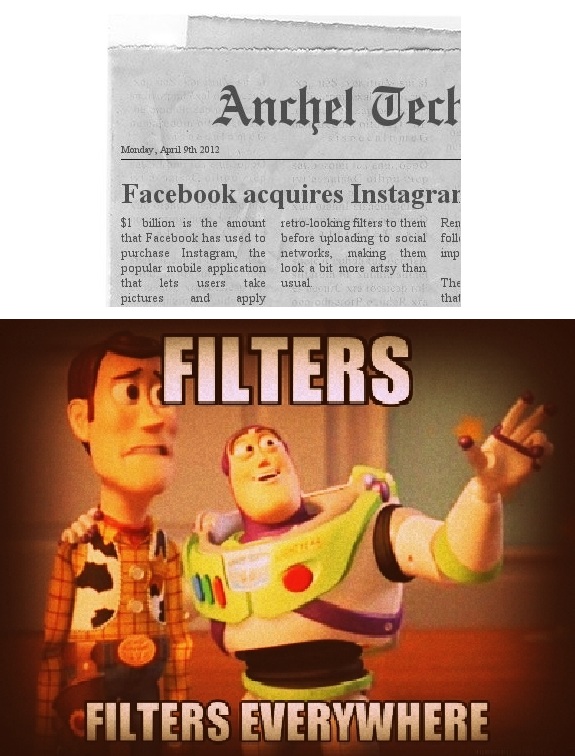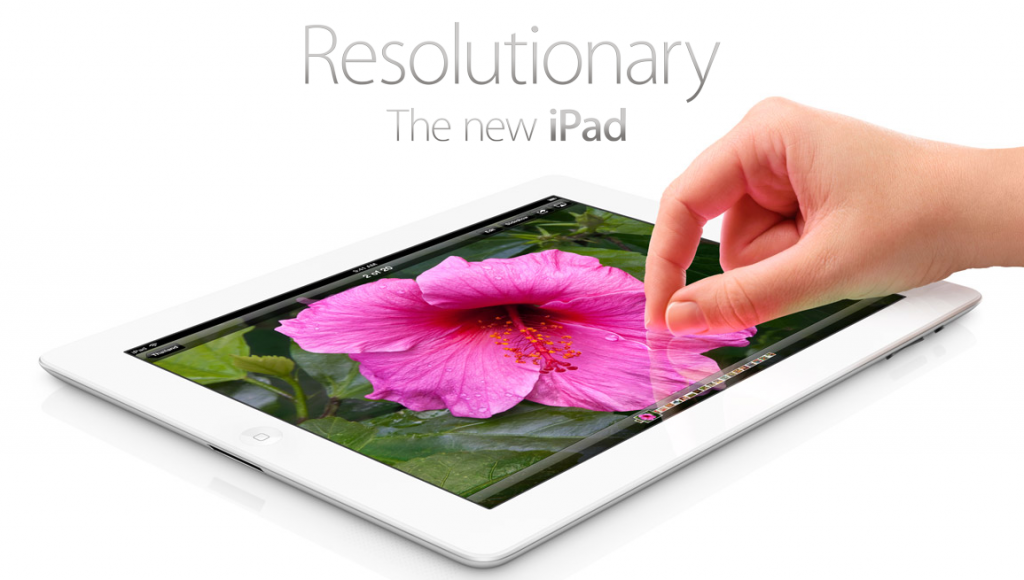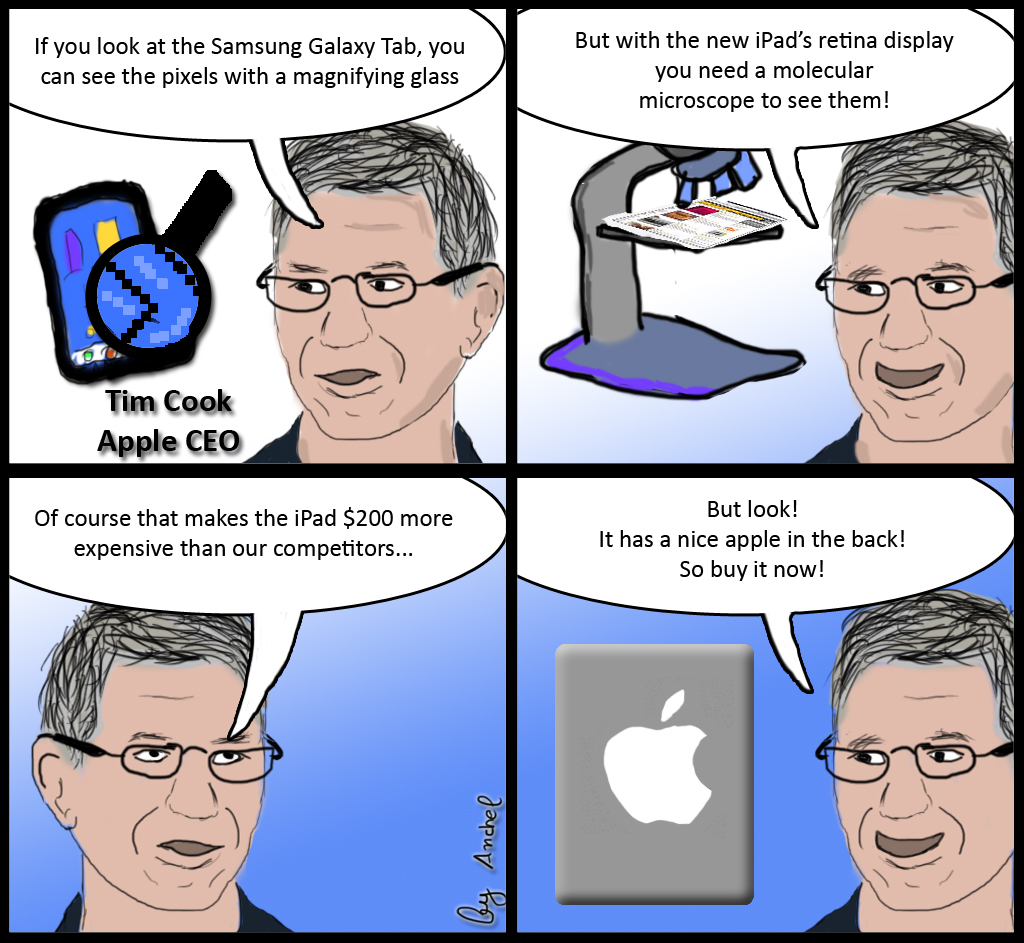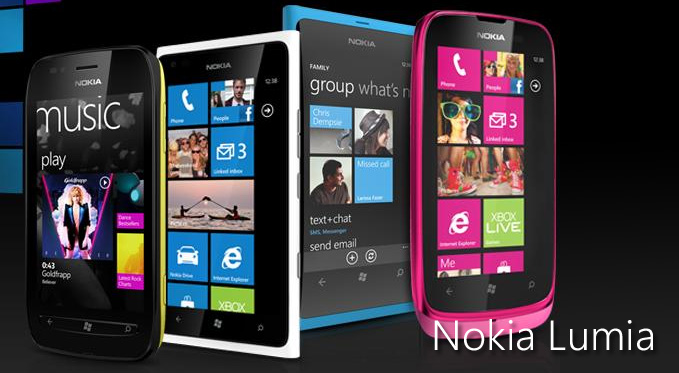This is all I have to say..
Category: Internet and technology
Anyone following me on Twitter or Facebook has probably already heard enough of my opinions on Apple’s latest announcements and their new generation iPad (which, by the way, ask any search engine optimization expert, and they will tell you that this is a terrible idea for a name).
But I wanted to take a few minutes to talk about why I think the announcement was a total disappointment.
It’s not because the new iPad is an awful device. Far from that, it’s probably the best tablet out there in number of apps, stability and design and, as Apple used to say, it simply works.
However we’ve all come to expect so much more from Apple than just better speed and a bigger resolution screen. It makes us think that this is not Apple we’re talking about, but instead any PC maker that simply upgrades their machines with better specs and cases them inside the same old. In fact, had Samsung or Sony presented these upgrades everyone would be incredibly happy with it and claim that this is the next revolution.
But it’s Apple who did it, and that’s a major downer.
Apple has got us used to always presenting “the next big thing”, to be leaders and innovators. Look at the day when Steve Jobs presented the first generation iPhone. That was a truly magical moment that changed the landscape of the entire mobile market. One year later and Apple announced the App Store, not a novel concept, but one done so well that everyone else had to follow suit. Look at the MacBook Air and compare it to what Intel is now finally trying to copy with its Ultrabooks.
And then there’s the iPad. A device that left everyone torn between this being a great idea or being a flunk. And time proved Apple was right, the iPad became a huge success.
That’s why when there’s a new Apple keynote coming up fans everywhere and even mainstream media start speculating about what Apple will surprise us with next. And usually they deliver, but that is simply not happening anymore.
The iPhone 4S presentation was an incredibly disappointing one for many: they all expected the iPhone 5, not a pumped up iPhone 4.
And the new iPad is just a rehash of that keynote. It’s faster. Oh, and it has a screen with a resolution so big that you’re not going to notice it is so good. In fact I feel that screen resolution is almost like buying an color TV to a color blind person.
I even made the following comic strip to represent my feelings on the new Retina Display:
But my point here is that Apple has got us all so used to delivering the next great piece of technology that will shape the future (in no small part thanks to its marketing strategy) that now, when they are simply not able to deliver something innovative, people get disappointed.
But you know what? It’s not going to affect Apple at all.
Their stocks fell a little bit yesterday, but I’m sure they will pick up, the new iPad sales will be excellent, and Apple will boast about it in their next keynote.
Meanwhile their competitors will fight to achieve something that gets any close to the iPad’s level of success. And they will keep failing at it just because they lack that marketing strategy to make things seem innovative.
But Apple, either you realize that you’re disappointing a lot of people or you won’t be able to keep up that “magical” aura out of your products.
Nokia’s return to form
Today was quite an interesting morning that gave the first official day of the Mobile World Congress 2012 in Barcelona a nice start. And it was all because of Nokia’s keynote with head honcho Stephen Elop.
Sure, the Nokia Asha line of phones is definitely a great addition for the company’s line-up, but those are not my main interest considering that they are designed for the emergent market at very low price points.
But on the other hand there was the Nokia Lumia family of phones. In just a few months we’ve seen now a total of 4 models with different shapes and styles and each one tailored for a separate userbase: the Lumia 800 and Lumia 710 came first as both a high-range and medium-range phones respectively, then came the Lumia 900 with a bigger screen and front-camera for the US market (now heading worldwide as well) and today the Lumia 610 joins Nokia’s Windows Phone 7 line.
Now though, ever since Elop announced that Nokia was jumping into the Windows Phone bandwagon because this allowed them to stand out and differentiate themselves there have been countless blog posts and comments saying that it was a stupid move and that Nokia should have either gone full-on with Meego or changed their track to Android. And I have been disagreeing with that point of view from the very first moment. Not because I think that Windows Phone is the superior platform, but because it was the most logical move for Nokia the way things were going for them.
Let’s face it: when was the last time you were genuinely surprised by a Nokia phone? What happened to the company that was once the true innovator of mobile technologies and biggest camera manufacturer in the world? Many could point at the Nokia N95 as the last phone that truly wowed the world, with its innovative form factor and high-end multimedia capabilities. But ever since then their offerings have always had problems everywhere: slow performance, a horrible, outdated user interface, cheap materials…
Joining forces with Android would have only been a disaster for the Finish company, who would have to bake a really outstanding custom UI in Android in order to gather some attention into the already over-crowded Android phone market. But at the same time that would have alienated many Android users who prefer things untouched in the OS and ready to be customized by them. Either way it was a losing situation. And the fact that the entire US market was lost to Nokia only made things worse.
Enter Windows Phone, Microsoft’s latest mobile operating system that has received a lot of praise for being something truly fresh and with intuitive design, though lacking in the apps department. As an OS that was starting to raise awareness among people on the streets, Nokia had the chance to spearhead the advance of the Windows Phone ecosystem by leading a space that was largely left untouched. And so it did, with incredibly positive results in pretty much every country where Nokia has started selling their new Lumia phones. It has effectively become the biggest vendor of Windows Phones, surpassing both HTC and Samsung. And it has done so by simply doing what Nokia does best: creating top-notch high quality designs, while letting Microsoft do their part on the OS.
And now look at the Lumia 610: it’s bound to become the entry-level Windows Phone to look at. And as far as low-end smartphones goes, this could very well be the most interesting one of them all. Look at Android smartphones: either you take the high-end or you end up with an extremely low budget phone with cheap plastics and a horrible user experience that runs slow and has problems running every app or scrolling down a contacts list, besides having a low screen resolution that makes things look cramped in the small screen.
The Lumia 610 on the other hand represents one of the biggest advantages of the Windows Phone platform: it still runs smooth, maintains the same screen resolution as its big brothers and keeps Nokia’s characteristic design aesthetics (although with a cheaper, less color-accurate screen and a plastic case). And Microsoft claims that only 5% of the current apps in the marketplace (which is now over 70.000 apps) won’t work as they are right now, though a few tweaks could make them work. This keeps fragmentation up to a minimum in a phone that is under the 200€ mark. Imagine doing that with Android phones.
This will be the phone that will introduce many to the Windows Phone ecosystem, and maybe smartphones as a whole. And the fact that as an entry smartphone it still manages to run smooth and with all the style of the Metro user interface only makes things more amazing for Nokia.
And then there’s the Nokia 808 PureView, the other grand announcement from Nokia at the MWC12.
Now, I’m a little bit torn on this one. Nokia has created a phone that has a 41 megapixel camera. And it runs Symbian.
What?
First the camera part: do we really need a phone with such a high photo resolution? Is it going to help anyone to keep excessively huge photos taking up space on their memory cards and slowing down the experience of scrolling through the photos? I mean, it should be clear that more megapixels doesn’t necessarily have to mean better quality pictures, but rather a big host of specs that go from the lens of the camera to the software that manages it. Nokia has shown us before that they know how to make cameras so I’m not too worried about the quality of these pictures. But those 41 megapixels sound more like a marketing gimmick than a real improvement, and Nokia is risking looking like a big gimmick to its customers.
But on the other hand this camera has its advantages. With such a high resolution it is possible to perform digital zoom to high levels without compromising the quality of the final picture. Yes, I know that digital zoom is not as good as a proper optical zoom. But when you consider that including an optical zoom in a phone would immediately mean a thicker, heavier phone, this option presents itself like a nice opportunity to improve the way camera phones evolve in the future.
As for the choice of the OS… I understand that Windows Phone as it is wouldn’t allow Nokia to create the necessary software adjustments needed to use this type of camera. At least not in its current version (leaks show that Apollo will allow OEMs to do a lot more with that). So Symbian was the way to go for now. I can see Nokia marketing this phone as a camera-enthusiast phone, aimed at that specific niche and not as a mainstream device, learning from it and improving what they can until they can use this new technology for their future phones, now on Microsoft’s platform.
Or at least that is my hope for them.
But all in all Nokia has shown us today that they are far from dead. The upcoming release of the Nokia 900 to the US market with the help of Microsoft’s push could allow the Finnish company to finally make a dent in the Android-iOS filled country where it always has had trouble establishing itself. And in Europe it can once again regain the lost market share with their cool designs that definitely make a difference in this era it almost feels like phones should always be black blocks with one button on the bottom of the screen.
Personally I’m looking forward to see the effect these new phones will have in the market as a whole. And of course I’ll be waiting impatiently to play with them on my own and put them to the test.
If you have been following my tweets, you probably know that I change web browsers on a constant basis. I really, really love the way the web has evolved in the past few years and I have been supporting several initiatives to get the web to work better.
But while I have most definitely used Google Chrome a lot, I have always had my second thoughts on it. It’s fast for sure, it loads pages correctly and it syncs my stuff online with other computers, which is awesome for those many times I have to format my computer or try some new device. But I kind of wanted to stay away from it.
In my quest to prove other browsers could be as good too I have heavily used Internet Explorer 9 (hey, it’s not as bad as many anti-IE users would like to make you believe), pinning my most frequently used websites to the taskbar in Windows 7, which made them work almost as if they were any other app in the OS. But eventually I would end up opening several tabs in these windows (like a link someone sent me on Facebook, or a picture in the Twitter window, or just web articles that link to one another…) and then I would have trouble finding out in which “application” I had this tab open, forcing me to look through all of them. Also the Flash plugin was giving me some hard time with it in my Nvidia Optimus managed laptop.
Alright, so let’s give Mozilla Firefox another try, I say! I’ve been a big Firefox supporter ever since it first came out as Phoenix in beta versions, recommending it to friends and family over the clunky and security-wise risky IE6. But over the years Firefox has become a giant monstrosity that acts slow, hogs your computer’s resources and, plain simple isn’t evolving as fast as its competitors. It took Mozilla an insane amount of time to deliver with Firefox 4, and though they have now changed the release schedule to something more similar to Google Chrome, the innovations are still not enough and, even then, it still feels clunky. So much for what used to be the fast browser out there…
I even gave Opera a fighting chance, with some features that quickly won me over like the new tab page’s active widgets, but it all ultimately fails when some websites don’t acknowledge Opera as a modern web browser simply because it still doesn’t include all the HTML5 standards that the big boys are pushing forward. And also it fails to render my blog properly.
As for Safari, this is as much as I will talk about it. It has the right support behind it, but that’s all it has going for it in my view.
So except for a few small players in the game the only option left here is Google Chrome.
And, let’s face it, Google has made here the single best web browser out there. It’s reliable, it’s standards compliant, it’s modern, it has extensions for all your needs, it’s simple yet powerful and, best of all, is designed to work whatever way you need it to.
But the thing is that Chrome has so many incredibly nice features built in right now that it not only has surpassed its competitors. It has already skyrocketed way past them. Heck, I even use Google Chrome as my standard PDF reader because it is much faster and stable than Adobe’s product!
And Chrome makes sure that your favorite websites act like true applications too! As you can see from the picture above, my new tab page is full of webapps, and I have TweetDeck pinned on the top left to be always open in Chrome. And all these icons, bookmarks and pinned tabs sync with the cloud, so that anytime I use Chrome in another computer (even on someone else’s computer through the new Profile Sign In feature) I have all my preferences right there.
Want to take things further? Google now supports by default their new Native Client technology. If that sounds just like fancy gibberish to you, all you need to know is that this new tech allows websites to run content natively on your computer safely. And this allows for deep, graphically intensive games like Bastion and Mini Ninjas to run fast and smooth, streaming only the data needed at hand from the web.
Google’s dream of a cloud-based OS has never been so close. Like literally I feel like I could do so many of my everyday tasks just on Chrome right now! And this comes from a heavy Microsoft Windows supporter…
I still have my reservations on allowing Google to take over my entire digital life, and Chrome OS is still lacking a few things that I need, but which are tremendously important for when the time comes. But as a web browser, Chrome is hands down, the best experience you will find right now for the web.
I’m genuinely excited about tomorrow’s (tonight depending on the region) announcement of Google’s next version of its Android operating system, named Ice-Cream Sandwich.
Even if I’m not an Android user I can appreciate the amazing versatility of the OS. But what had always worried me most about Android was its fragmentation problems and total lack of control when it comes to its UI (not from the user-end, since Android is the most customizable of them all).
And as far as I can tell Ice-Cream Sandwich is going to take huge steps forward to clean all that mess.
The Froyo update was amazing, and Gingerbread had some nifty additions. Honeycomb is surprising but still too young and untested, and so far only for tablets. Ice-Cream Sandwich seems to blend both versions together. Or at least that is my most sincere wish. I want to see Android unified, with an interface that is pleasing to the eye.
And Samsung might deliver just that tomorrow with the next Google Nexus phone. No skins, no TouchWiz additions, just plain vanilla Android. Let’s hope it is as sweet as its logo.
Oh, and if you ask me, I really think that Samsung here can pull a phone that will leave the iPhone 4S in shame.
The presentation will start at 4 AM (GMT +1), so I will not cover the event until later on in the day.
I’m fairly surprised with the iPhone 4S Siri assistant.
No, really. I am!
Not because it’s something absolutely new (in fact Apple is the latest one to jump into the voice recognition game) but because they have pulled it out with style.
I don’t think Siri will be useful at all besides typical functions like composing a text message or performing a basic web search. I mean, come on, are you really going to trust a voice-recognition system in scheduling your appointments without double-checking first that it hasn’t made a mistake? So in that regard it’s the same as what most competitors already have.
But Siri also has a fun factor that the others lack. As an example here are a few funny real replies of Siri taken by Joshua Topolsky from ThisIsMyNext.com:























